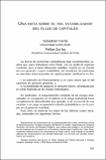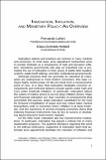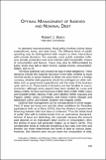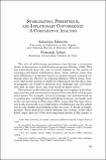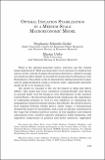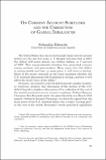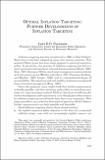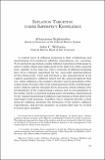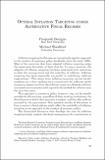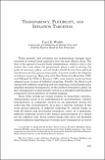Buscar
Mostrando ítems 281-290 de 323
Una nota sobre el rol estabilizador del flujo de capitales
La teoría de economías competitivas bajo incertidumbre explica que, para individuos como Chile, con un perfil de ingresos creciente, pero a tasas altamente volátiles, inserto en un mundo de—en general— menor volatilidad, los beneficios de participar en mercados internacionales de capital pueden ...
Indexation, inflation, and monetary policy: an overview
Indexation policies and practices are common in many markets and economies. In most cases, price adjustment mechanisms arise in private contracts as a consequence of high and pervasive inflation. Sometimes governments also play an important role in promoting the use of indexation in their issues of ...
Optimal management of indexed and nominal debt
In standard macroeconomics, fiscal policy involves choices about expenditures, taxes, and debt issue. The different kinds of public spending may be distinguished with respect to their interactions with private decisions. For example, some public activities influence private production and some interact ...
Stabilization, persistence, and inflationary convergence: a comparative analysis
The role of inflationary persistence has become a recurrent theme in discussions on stabilization programs (Fischer, 1986). This has particularly been the case in recent debates on the merits of exchange-rate-based stabilization plans. Some authors claim that anti-inflationary programs based on ...
Optimal inflation stabilization in a medium-scale macroeconomic model
What is the optimal monetary policy, and how can the central bank implement it? Both questions have been extensively studied, but always in the context of simple theoretical structures, which by design are limited in their ability to account for actual observed business cycle fluctuations. This article ...
On current account surpluses and the correction of global imbalances
The United States has run an increasingly large current account deficit over the last few years. J. P. Morgan forecasts that in 2007 the deficit will reach almost one trillion dollars, or 7 percent of GDP. This unprecedented situation has generated concern among analysts and policymakers. Many argue ...
Optimal inflation targeting: further developments of inflation targeting
Inflation targeting was first introduced in 1990, in New Zealand. Since then it has been adopted by more than twenty countries. This period of fifteen years has seen major progress in practical monetary policy. In particular, the practice of inflation targeting has led to a more systematic and consistent ...
Inflation targeting under imperfect knowledge
A central tenet of inflation targeting is that establishing and maintaining well-anchored inflation expectations are essential. Well-anchored expectations enable inflation-targeting central banks to achieve stable output and employment in the short run, while ensuring price stability in the long run. ...
Optimal inflation targeting under alternative fiscal regimes
Inflation targeting has become an increasingly popular approach to the conduct of monetary policy worldwide since the early 1990s. Most of the countries that have adopted inflation targeting judge the experiment favorably, at least thus far. In many countries, the adoption of inflation targeting has ...
Transparency, flexibility, and inflation targeting
Three parallel and certainly not independent changes have occurred in central bank practices over the past fifteen years. The first is the spread of central bank independence, which is tied to the notion that even when the government plays a role in setting the goals of monetary policy, central banks ...

